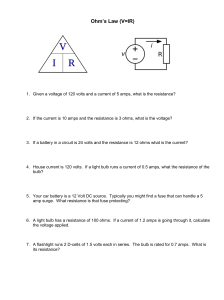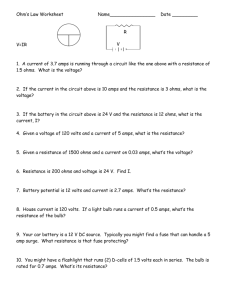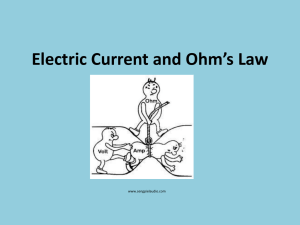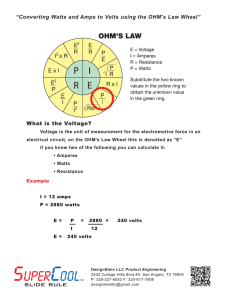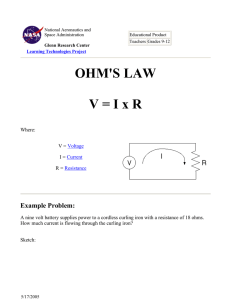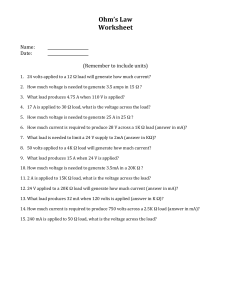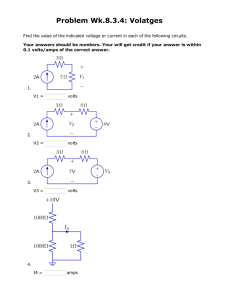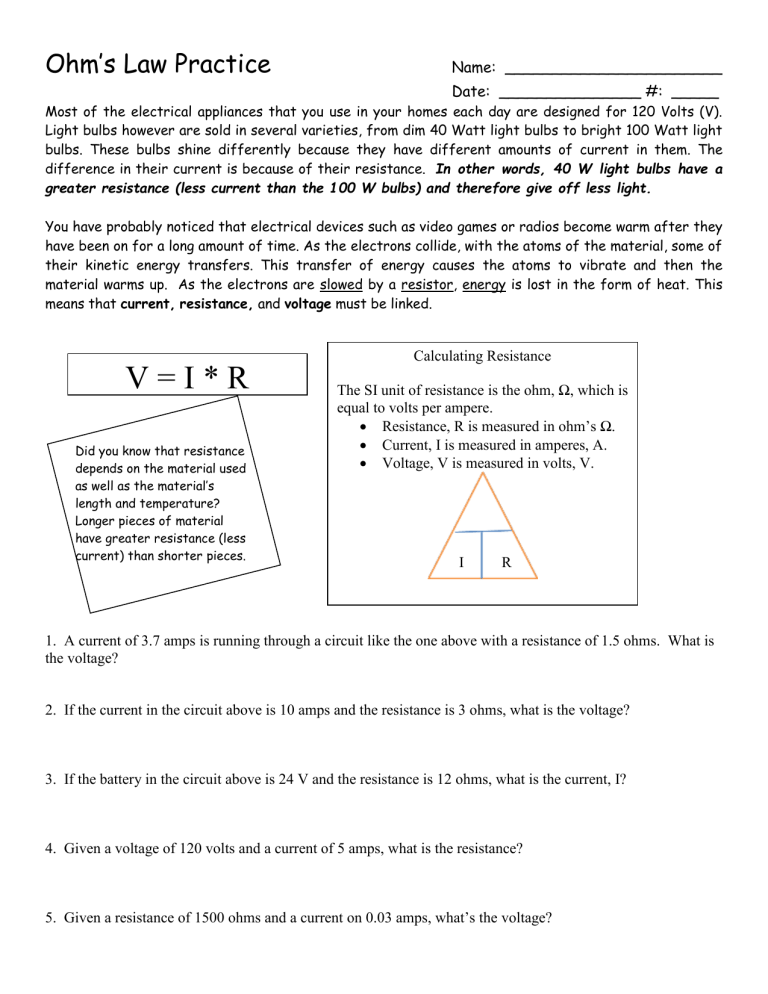
Ohm’s Law Practice Name: _______________________ Date: _______________ #: _____ Most of the electrical appliances that you use in your homes each day are designed for 120 Volts (V). Light bulbs however are sold in several varieties, from dim 40 Watt light bulbs to bright 100 Watt light bulbs. These bulbs shine differently because they have different amounts of current in them. The difference in their current is because of their resistance. In other words, 40 W light bulbs have a greater resistance (less current than the 100 W bulbs) and therefore give off less light. You have probably noticed that electrical devices such as video games or radios become warm after they have been on for a long amount of time. As the electrons collide, with the atoms of the material, some of their kinetic energy transfers. This transfer of energy causes the atoms to vibrate and then the material warms up. As the electrons are slowed by a resistor, energy is lost in the form of heat. This means that current, resistance, and voltage must be linked. Calculating Resistance V=I*R Did you know that resistance depends on the material used as well as the material’s length and temperature? Longer pieces of material have greater resistance (less current) than shorter pieces. The SI unit of resistance is the ohm, Ω, which is equal to volts per ampere. Resistance, R is measured in ohm’s Ω. Current, I is measured in amperes, A. Voltage, V is measured in volts, V. V I R 1. A current of 3.7 amps is running through a circuit like the one above with a resistance of 1.5 ohms. What is the voltage? 2. If the current in the circuit above is 10 amps and the resistance is 3 ohms, what is the voltage? 3. If the battery in the circuit above is 24 V and the resistance is 12 ohms, what is the current, I? 4. Given a voltage of 120 volts and a current of 5 amps, what is the resistance? 5. Given a resistance of 1500 ohms and a current on 0.03 amps, what’s the voltage? 6. Resistance is 200 ohms and voltage is 24 V. Find the amperage. 7. Battery potential is 12 volts and current is 2.7 amps. What’s the resistance? 8. House voltage is 240 volts. If a light bulb runs a current of 0.5 amps, what’s the resistance of the bulb? 9. Your car battery is a 12 V DC source. Typically you might find a fuse that can handle a 5 amp surge. What resistance is that fuse protecting? 10. You might have a flashlight that runs (2) D-cells of 1.5 volts each in series. The bulb is rated for 0.7 amps. What’s its resistance? Ohm’s Law Questions 1. What is the SI unit for resistance? What is its symbol? 2. What is current measured in? What is its symbol? 3. What is voltage measured in? What is its symbol? 9. How much current flows through a circuit in which the voltage is 9 volts and the resistance is 3 ohms? 10. What is the resistance of a wire that has a voltage of 1.5 volts and a current of 0.5 amps? 4. What is the formula for Ohm’s Law? 5. What formula would you use to solve for resistance? 11. What happens to current as voltage increases? 6. What formula would you use to solve for current? 12. Which would have the highest resistance? A 100 W bulb or 40 W bulb? 7. What formula would you use to solve for voltage? 8. In an electrical field, the resistance is 2 ohms and the current is 4 amps. What is the voltage? 13. Which would have the highest resistance? Insulators or conductors?
